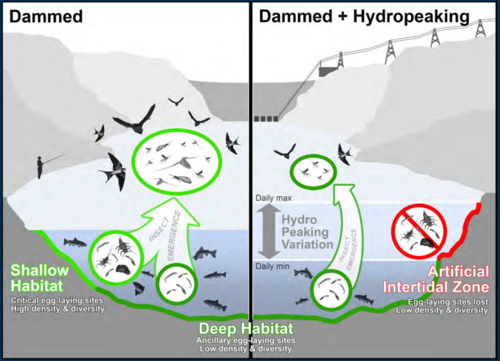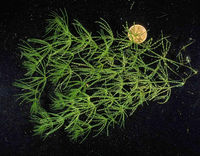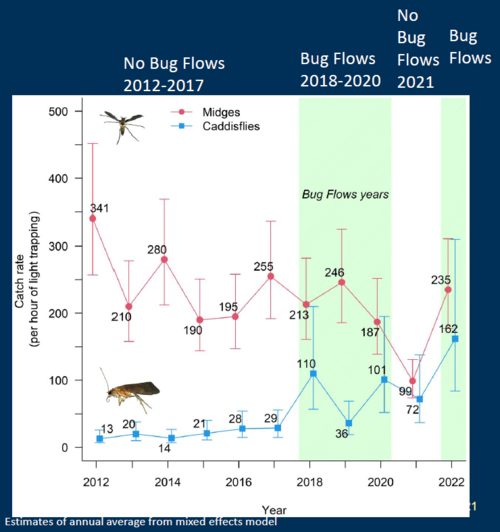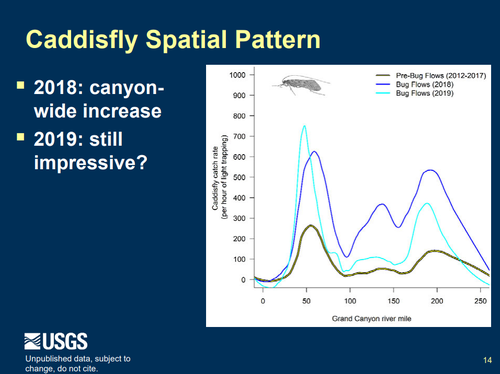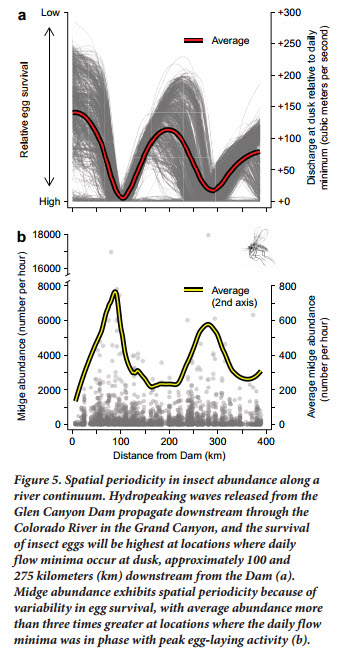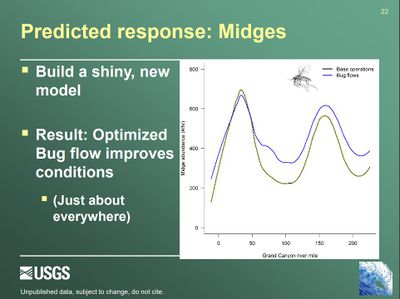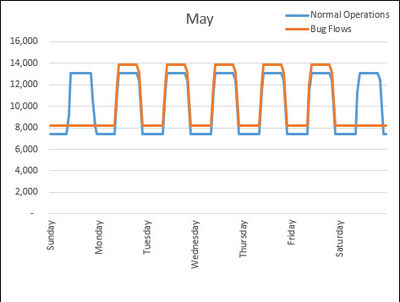Difference between revisions of "The Bugflow Experiment"
Cellsworth (Talk | contribs) |
Cellsworth (Talk | contribs) |
||
| (80 intermediate revisions by the same user not shown) | |||
| Line 17: | Line 17: | ||
</table> | </table> | ||
| − | [[File: | + | [[File:BugflowModel.PNG|thumb|center|500px|https://www.usbr.gov/uc/progact/amp/twg/2022-01-13-twg-meeting/20220113-AnnualReportingMeeting-ProjectF-AquaticEcologyFoodBaseMonitoring-508-UCRO.pdf]] |
| − | + | ||
<!-- | <!-- | ||
| Line 25: | Line 24: | ||
|style="width:60%; font-size:120%;"| | |style="width:60%; font-size:120%;"| | ||
| − | '''What is the “Macroinvertebrate Production Flow (MPF)" experiment?''' <br> | + | '''What is the “Macroinvertebrate Production Flow (MPF)" or "Bug Flow" experiment?''' <br> |
| − | This would be an experimental release at Glen Canyon Dam to see if short-duration steady | + | This would be an experimental release at Glen Canyon Dam to see if short-duration steady releases might increase the diversity and production of aquatic insects below Glen Canyon Dam. This experiment is included in the Preferred Alternative of the [http://gcdamp.com/index.php?title=Long-term_Experimental_and_Management_Plan_(LTEMP) LTEMP DEIS]. These “macroinvertebrate production flows” would occur from May to August and would maintain releases on the weekends to a level equal to the minimum release made during the week. This would allow aquatic insects two days a week throughout the river corridor to be able to lay their eggs at a stage where they would not be at risk of being dewatered or desiccated. The experiment would include monitoring to evaluate if the flows did increase the diversity and production of aquatic insects. The experiment was designed to test the hypothesis put forward in [[Media:Kennedy 2016 HydropowerEPT.pdf| '''Kennedy's 2016 BioScience Paper''']] while minimizing impacts to the hydropower resource at Glen Canyon Dam by having the steady flows on the weekend. This results in a transfer of water from the weekend to the weekdays increasing the daily minimums and maximums and the range of fluctuation during the week. Western believes that this experiment will result in only a small decrease in the energy value, but a modest increase in the capacity value of hydropower produced at Glen Canyon Dam. |
| + | |||
| + | Bugflows were implemented May-August in 2018, 2019, 2020, and 2022. | ||
|}<!-- | |}<!-- | ||
| Line 32: | Line 33: | ||
----------Strapline immediately below banner----------> | ----------Strapline immediately below banner----------> | ||
{| style="width:100%; height:50px" border=1px solid #ccc; background:#cedff2 | {| style="width:100%; height:50px" border=1px solid #ccc; background:#cedff2 | ||
| − | ! style="width=33%; background:#cedff2;" | [[ | + | ! style="width=33%; background:#cedff2;" | [[File:EPT.jpg|center|500px]] [https://www.wcc.nrcs.usda.gov/ftpref/wntsc/strmRest/wshedCondition/EPTIndex.pdf EPT as Biologic Indicators of Stream Condition] <br> |
| − | ! style="width=33%; background:#cedff2;" | [[ | + | ! style="width=33%; background:#cedff2;" | [[File:Chara.jpg|center|200px]] [[Algae and Aquatic Macrophytes]] <br> |
| − | ! style="width=55%; background:#cedff2;" | [[ | + | ! style="width=55%; background:#cedff2;" | [[File:Macroinvertebrates.jpg|center|400px]] [[Aquatic Macroinvertebrates]] <br> |
|} | |} | ||
| Line 40: | Line 41: | ||
|class="MainPageBG" style="width:65%; border:1px solid #cef2e0; background:#f5faff; vertical-align:top; color:#000;"| | |class="MainPageBG" style="width:65%; border:1px solid #cef2e0; background:#f5faff; vertical-align:top; color:#000;"| | ||
{|width="100%" cellpadding="2" cellspacing="5" style="vertical-align:top; background:#f5faff;" | {|width="100%" cellpadding="2" cellspacing="5" style="vertical-align:top; background:#f5faff;" | ||
| − | ! <h2 style="margin:0; background:#cedff2; font-size:120%; font-weight:bold; border:1px solid #a3bfb1; text-align:left; color:#000; padding:0.2em 0.4em;">Updates</h2> | + | ! <h2 style="margin:0; background:#cedff2; font-size:120%; font-weight:bold; border:1px solid #a3bfb1; text-align:left; color:#000; padding:0.2em 0.4em;"> Updates </h2> |
|- | |- | ||
|style="color:#000;"| | |style="color:#000;"| | ||
| + | [[File:MidgeCaddisCatch_2012to2022.PNG|thumb|center|500px| [[Media:Kennedy JuneTWG for BAO.pdf| Experimental Bug Flows Enhance Natural Processes That Sustain The Colorado River Ecosystem]] ]] | ||
| + | [[File:2019 caddis pattern.PNG|thumb|center|500px| [https://www.usbr.gov/uc/progact/amp/twg/2020-01-13-twg-meeting/20200113-AnnualReportingMeeting-Year2BugFlows-Presentation-508-UCRO.pdf| https://www.usbr.gov/uc/progact/amp/twg/2020-01-13-twg-meeting/20200113-AnnualReportingMeeting-Year2BugFlows-Presentation-508-UCRO.pdf] ]] | ||
|- | |- | ||
| − | ! <h2 style="margin:0; background:#cedff2; font-size:120%; font-weight:bold; border:1px solid #a3b0bf; text-align:left; color:#000; padding:0.2em 0.4em;"> | + | ! <h2 style="margin:0; background:#cedff2; font-size:120%; font-weight:bold; border:1px solid #a3b0bf; text-align:left; color:#000; padding:0.2em 0.4em;"> Primary causal mechanism </h2> |
| − | </h2> | + | |
|- | |- | ||
|style="color:#000;"| | |style="color:#000;"| | ||
| − | ==[http://ltempeis.anl.gov/documents/final-eis/vol1/Chapter_2-Alternatives.pdf Chapter 2 LTEMP EIS, Page 71]== | + | '''Hypothesis:''' Daily flow fluctuations dry (desiccate) and kill eggs laid in the evening along the shorelines resulting in population level declines in the abundance and diversity of aquatic macroinvertebrates (midges and EPT) below Glen Canyon Dam. <br> |
| + | '''Questions:''' Will bugflows increase the abundance and diversity of aquatic macroinvertebrates (midges and EPT) below Glen Canyon Dam? | ||
| + | *In areas where evening egg laying is out of sync with the daily hydropower wave (Glen Canyon, Upper and Lower Granite Gorge), can we detect increased egg laying and egg survival during the low weekend flow? | ||
| + | *If observed, does increased egg laying and survival translate into increased larval and adult abundance and diversity? | ||
| + | *Additionally, steady flows are know to reduce aquatic macroinvertebrate drift. Do increases in production and diversity, if observed, compensate for any decrease in drift? <br> | ||
| + | |||
| + | [[File:MidgeAbundanceFlow.jpg|thumb|center|400px| [http://gcdamp.com/images_gcdamp_com/7/70/Kennedy_2016_HydropowerEPT.pdf BioScience Paper] ]] | ||
| + | [[File:BugflowsPrediction.JPG|thumb|center|400px| [https://www.usbr.gov/uc/progact/amp/twg/2018-01-25-twg-meeting/AR10.pdf https://www.usbr.gov/uc/progact/amp/twg/2018-01-25-twg-meeting/AR10.pdf] ]] | ||
| + | |||
| + | |- | ||
| + | ! <h2 style="margin:0; background:#cedff2; font-size:120%; font-weight:bold; border:1px solid #a3b0bf; text-align:left; color:#000; padding:0.2em 0.4em;"> How are Bugflows going to be monitored? </h2> | ||
| + | |- | ||
| + | |style="color:#000;"| | ||
| + | |||
| + | *[https://www.usgs.gov/centers/sbsc/science/citizen-science-light-trapping-grand-canyon?qt-science_center_objects=0#qt-science_center_objects Citizen Science light trap monitoring throughout Glen and Grand Canyons] | ||
| + | *Drift: every 5 miles in Glen and Grand Canyons | ||
| + | *Weekday vs weekend drift | ||
| + | |||
| + | |- | ||
| + | ! <h2 style="margin:0; background:#cedff2; font-size:120%; font-weight:bold; border:1px solid #a3b0bf; text-align:left; color:#000; padding:0.2em 0.4em;"> How will we know if Bugflows are successful? </h2> | ||
| + | |- | ||
| + | |style="color:#000;"| | ||
| + | |||
| + | *See a smoothing of the spatial pattern in midges in Grand Canyon | ||
| + | *Increase in midges throughout Glen and Grand Canyons | ||
| + | *Increase in caddisflies (and other EPT) throughout Glen and Grand Canyons | ||
| + | |||
| + | |} | ||
| + | |||
| + | |||
| + | <!-- | ||
| + | |||
| + | --------------------------------ADDITIONAL-------------------------------> | ||
| + | |class="MainPageBG" style="width:65%; border:1px solid #cedff2; background:#f5faff; vertical-align:top;"| | ||
| + | {| width="100%" cellpadding="2" cellspacing="5" style="vertical-align:top; background:#f5faff;" | ||
| + | ! <h2 style="margin:0; background:#cedff2; font-size:120%; font-weight:bold; border:1px solid #a3b0bf; text-align:left; color:#000; padding:0.2em 0.4em;">Information and Links</h2> | ||
| + | |- | ||
| + | |style="color:#000;"| | ||
| + | |||
| + | [http://gcdamp.com/index.php?title=FOOD_BASE Food Base Page] | ||
| + | |||
| + | [http://gcdamp.com/index.php?title=%27%27%27Oviposition_and_Egg_Desiccation%27%27%27 Oviposition and Egg Desiccation Studies] | ||
| + | |||
| + | [http://gcdamp.com/index.php?title=Foodwebs_and_Bioenergetics Foodwebs and Bioenergetics Studies] | ||
| + | |||
| + | [https://www.gcmrc.gov/research_areas/food_base/primary_production.aspx Measuring Primary Production in the Lees Ferry Reach] | ||
| + | |||
| + | Effects of [http://gcdamp.com/index.php?title=The_Bugflow_Experiment BugFlows] and [http://gcdamp.com/index.php?title=The_HFE_Page HFEs] on the Aquatic Foodbase | ||
| + | *[https://www.usgs.gov/centers/sbsc/science/citizen-science-light-trapping-grand-canyon?qt-science_center_objects=0#qt-science_center_objects Citizen Science Insect Monitoring] | ||
| + | |||
| + | Hyporheic anoxia in the Lees Ferry Reach | ||
| + | |||
| + | Substrate condition and availability for EPT below Glen Canyon Dam | ||
| + | |||
| + | Downstream Recovery of the Foodbase Community in Several Colorado River Tailwaters | ||
| + | |||
| + | Drift and Food Availability Studies | ||
| + | *[https://www.gcmrc.gov/research_areas/food_base/invertebrate_drift.aspx Invertebrate Drift below Glen Canyon Dam ] | ||
| + | *[http://www.usu.edu/buglab/Projects/CurrentProjects/#item=33 Responses of macroinvertebrate drift, benthic assemblages and trout foraging to hydropeaking below Flaming Gorge Dam] | ||
| + | |||
| + | |- | ||
| + | ! <h2 style="margin:0; background:#cedff2; font-size:120%; font-weight:bold; border:1px solid #a3b0bf; text-align:left; color:#000; padding:0.2em 0.4em;"> Resources that might be affected </h2> | ||
| + | |- | ||
| + | |style="color:#000;"| | ||
| + | |||
| + | *Foodbase: abundance, diversity, availability (drift) | ||
| + | *Hydropower: value, capacity | ||
| + | *Trout and native fisheries: production, condition | ||
| + | *Lees Ferry fishery: access, economics | ||
| + | *Boater safety: Glen Canyon, downstream | ||
| + | *Sediment transport: beaches | ||
| + | |||
| + | |- | ||
| + | ! <h2 style="margin:0; background:#cedff2; font-size:120%; font-weight:bold; border:1px solid #a3b0bf; text-align:left; color:#000; padding:0.2em 0.4em;"> Financial costs of the experiment </h2> | ||
| + | |- | ||
| + | |style="color:#000;"| | ||
| + | |||
| + | *The cost of the 2018 Bugflow Experiment was $165,000 [https://publications.anl.gov/anlpubs/2019/06/151429.pdf] <br> | ||
| + | *The cost of the 2019 Bugflow Experiment was $327,000 [https://publications.anl.gov/anlpubs/2020/12/163982.pdf] <br> | ||
| + | *The cost of the 2020 Bugflow Experiment was $941,000 [[Media:2020BugFlowsFinancials.pdf| (3)]]<br> | ||
| + | The three-year (2018-2020) total of doing the Bugflow Experiment is $1,433,000 <br> | ||
| + | |||
| + | *The cost estimate for doing a Bugflow Experiment in 2021 (which wasn't implemented) was $1,021,000 <br> | ||
| + | *The cost of the 2022 Bugflow Experiment was $1,154,000 [https://publications.anl.gov/anlpubs/2019/06/151429.pdf] <br> | ||
| + | |||
| + | |- | ||
| + | ! <h2 style="margin:0; background:#cedff2; font-size:120%; font-weight:bold; border:1px solid #a3b0bf; text-align:left; color:#000; padding:0.2em 0.4em;"> Possible confounding factors </h2> | ||
| + | |- | ||
| + | |style="color:#000;"| | ||
| + | |||
| + | *Tributary inflows make mainstem flows anything but "steady" through Grand Canyon | ||
| + | *Changes in nutrients, turbidity, and temperature are also thought to be strong drivers of macroinvertebrate production | ||
| + | *Bugflows may have a compounding affect on production that may not be seen for many bug generations (months to years) | ||
| + | |||
| + | |- | ||
| + | ! <h2 style="margin:0; background:#cedff2; font-size:120%; font-weight:bold; border:1px solid #a3b0bf; text-align:left; color:#000; padding:0.2em 0.4em;">Papers and Presentations </h2> | ||
| + | |- | ||
| + | |style="color:#000;"| | ||
| + | |||
| + | '''2023''' | ||
| + | *[https://www.usbr.gov/uc/progact/amp/twg/2023-04-13-twg-meeting/20230413-BugsPayDaysSteadyReservoirReleases-508-UCRO.pdf Bugs pay for days of steady reservoir releases] | ||
| + | *[https://www.usbr.gov/uc/progact/amp/amwg/2023-02-16-amwg-meeting/20230216-ScienceUpdateLakePowellRiparianVegetationBugFlows-508-UCRO.pdf Science Update: Lake Powell, Riparian Vegetation, and Bug Flows] | ||
| + | *[[Media:Kennedy JuneTWG for BAO.pdf| Experimental Bug Flows Enhance Natural Processes That Sustain The Colorado River Ecosystem]] | ||
| + | *[[Media:1100_TWGQnA_bugflow_20230615.pdf| Bugflows Q&A]] | ||
| + | *[https://www.usbr.gov/uc/progact/amp/twg/2023-01-26-twg-meeting/20230126-AnnualReportingMeeting-BugFlowsFoodBaseUpdate-508-UCRO.pdf Project F: Bug Flows and food base update] | ||
| + | |||
| + | '''2022''' | ||
| + | *[https://www.usbr.gov/uc/progact/amp/amwg/2022-08-18-amwg-meeting/20220818-Kennedy_Update_Bug_Flow_AMWG_BAO_508.pdf Update on the Bug Flow Experiment: Background, Monitoring, and New Analyses] | ||
| + | *[[Media:Decision Memo on Bug Flows 2022 08 12.pdf| August 2022 BugFlow Decision memo]] | ||
| + | *[[Media:Summary Bug Flow Tech Analyses and Comments 2022 08 12.pdf| August 2022 Summary Bug Flow Tech Analyses and Comments ]] | ||
| + | *[[Media:2022_BugFlow_Decision_memo_Final_wgp.pdf| April 2022 BugFlow Decision memo]] | ||
| + | *[[Media:2022.04.11 - Technical Recommendation Report - Bug Flows 2022 - FINAL wAttach - Copy.pdf| April 2022 Technical Recommendation Report]] | ||
| + | *[https://www.usbr.gov/uc/progact/amp/twg/2022-01-13-twg-meeting/20220113-AnnualReportingMeeting-DiscussionBugFlowsSynthesisReviewOpportunitiesSpringSummerFlowExperiments-508-UCRO.pdf Discussion of the Bug Flows Synthesis and Review & Opportunities for Spring and Summer Flow Experiments ] | ||
| + | *[https://www.usbr.gov/uc/progact/amp/amwg/2022-05-18-amwg-meeting/20220518-BugFlowsFY2022-508-UCRO.pdf Bug Flows FY2022 ] | ||
| + | |||
| + | '''2021''' | ||
| + | *[https://www.usbr.gov/uc/progact/amp/twg/2021-10-14-twg-meeting/20211014-MacroInvertebrateFlowExperimentFinancialImpactHydropower-Presentation-508-UCRO.pdf Macro Invertebrate Flow Experiment Financial Impact on Hydropower: Process and Methods] | ||
| + | *[https://www.usbr.gov/uc/progact/amp/twg/2021-04-14-twg-meeting/20210414-DiscussionAnticipatedScopeForthcomingBugFlowEvaluationDocument-508-UCRO.pdf Discussion of the Anticipated Scope of the Forthcoming Bug Flow Evaluation Document ] | ||
| + | *[https://www.usbr.gov/uc/progact/amp/twg/2021-01-22-twg-meeting/20210122-BugFlows-508-UCRO.pdf Bug Flows ] | ||
| + | |||
| + | '''2020''' | ||
| + | *[[Media:2020BugFlowsFinancials.pdf| Financial Analysis of the 2020 Glen Canyon Dam Bug Flow Experiment]] | ||
| + | *[https://www.usbr.gov/uc/progact/amp/twg/2020-10-15-twg-meeting/20201015-UpdateBugFlowsExperiment-Presentation-508-UCRO.pdf Update on the Bug Flows Experiment ] | ||
| + | *[https://www.usbr.gov/uc/progact/amp/amwg/2020-08-20-amwg-meeting/20200820-WY20LTEMPExp-AugAMWG.pdf Potential Water Year 2021 LTEMP Experiments & Bug Flow Update] | ||
| + | *[https://www.usbr.gov/uc/progact/amp/amwg/2020-05-20-amwg-meeting/20200520-AMWG-PotentialWaterYear2020LTEMPExperimentsBugFlowUpdate-508-UCRO.pdf Potential Water Year 2020 LTEMP Experiments & Bug Flow Update ] | ||
| + | *[https://www.usbr.gov/uc/progact/amp/twg/2020-04-15-twg-meeting/20200415-BugFlowsMonitoringResults-Presentation-508-UCRO.pdf Bug Flows Monitoring Results ] | ||
| + | *[https://www.usbr.gov/uc/progact/amp/amwg/2020-02-12-amwg-meeting/20200212-GCMRC2020AnnualReportingMeeting-PresentationPart1-508-UCRO.pdf GCMRC 2019 Annual Reporting Meeting Overview – Part 1 ] | ||
| + | *[https://www.knau.org/post/colorado-river-bugs-spark-two-unprecedented-experiments-opposite-goals Colorado River Bugs Spark Two Unprecedented Experiments With Opposite Goals] | ||
| + | *[https://www.usbr.gov/newsroom/newsrelease/detail.cfm?RecordID=70708 Water experiment to be conducted along the Colorado River while maintaining hydropower production this summer] | ||
| + | *[[Media:2020-04-24 ASWS Approval Memo on Implementing Bug Flows.pdf| Approval of recommendation for macroinvertebrate production flow releases at Glen Canyon Dam, May 1 through August, 2020]] | ||
| + | *[[Media:Attachment - FINAL 2020 GCD Planning Implementation Team Bug Flows Recommendation Report.pdf| 2020 GCD Planning Implementation Team Bug Flows Recommendation Report]] | ||
| + | *[[Media:Metcalf etal 2020 Bug flows Don't count your midges-BQR article.pdf |Metcalfe et. al., 2020, Bug flows--Don't count your midges until they hatch: Boatman's Quarterly Review]] | ||
| + | *[https://www.usbr.gov/uc/progact/amp/twg/2020-01-13-twg-meeting/20200113-AnnualReportingMeeting-TroutRecruitmentGrowthPopulationDynamics-Presentation-508-UCRO.pdf TRGD: Trout Recruitment, Growth and Population Dynamics ] | ||
| + | *[https://www.usbr.gov/uc/progact/amp/twg/2020-01-13-twg-meeting/20200113-AnnualReportingMeeting-Year2BugFlows-Presentation-508-UCRO.pdf Year 2 of Bug Flows ] | ||
| + | |||
| + | '''2019''' | ||
| + | *[[Media:2019BugFlowsFinancials.pdf| Financial Analysis of the 2019 Glen Canyon Dam Bug Flow Experiment]] | ||
| + | *[[Media:2019-04-24 ASWS Decision Memo on Implementing Bug Flows.pdf| ASWS Decision Memo on Implementing Bug Flows]] | ||
| + | *[[Media:2019 GCD Planning Implementation Team Bug Flows Recommendation Report final.pdf| 2019 GCD Planning Implementation Team Bug Flows Recommendation Report]] | ||
| + | *[[Media:2019-04-19 GCD Planning Implementation Team Bug Flows Recommendation to GCD Leadership Team.pdf| GCD Planning Implementation Team Bug Flows Recommendation to GCD Leadership Team]] | ||
| + | *[https://www.usbr.gov/uc/progact/amp/twg/2019-03-14-twg-meeting/20190314-BugFlowsImplementationResourceResponse-Presentation-508-UCRO.pdf Bug Flows Implementation and Resource Response Presentation ] | ||
| + | *[https://www.usbr.gov/uc/progact/amp/amwg/2019-03-06-amwg-meeting/20190306-ModelingInputBugflowExperimentSummer2018-Presentation-508-UCRO.pdf Modeling Input for the Bugflows Experiment - Summer, 2018 Presentation] | ||
| + | *[https://www.usbr.gov/uc/progact/amp/twg/2019-03-14-twg-meeting/20190314-BugFlowsImplementationResourceResponse-Presentation-508-UCRO.pdf Bug Flows Implementation and Resource Response Presentation ] | ||
| + | |||
| + | '''2018''' | ||
| + | *[https://publications.anl.gov/anlpubs/2019/06/151429.pdf Financial Analysis of the 2018 Glen Canyon Dam Bug Flow Experiment] | ||
| + | *[https://www.usbr.gov/uc/progact/amp/amwg/2018-08-22-amwg-meeting/Attach_05.pdf Do bug flows result in better fishing? PPT] | ||
| + | *[https://www.usbr.gov/uc/progact/amp/amwg/2018-08-22-amwg-meeting/Attach_04.pdf Update on the Progress of the Bug Flow Experiment PPT ] | ||
| + | *[https://www.usbr.gov/uc/progact/amp/amwg/2018-05-22-amwg-meeting/Attach_06.pdf Approval of Recommendation for Macroinvertebrate Production Flow Releases at Glen Canyon Dam, May 1 through August 31, 2018] | ||
| + | *[[Media:2018 BugFlow memo - ASWS signature.pdf| 2018 BugFlow memo]] | ||
| + | *[[Media:2018 GCD Experimental Technical Team Report final.pdf| 2018 GCD Experimental Technical Team Report - Bugflows]] | ||
| + | *[https://www.usbr.gov/uc/progact/amp/twg/2018-01-25-twg-meeting/AR10.pdf Bug flow optimizations and predictions PPT] | ||
| + | |||
| + | '''2016''' | ||
| + | *[[Media:Kennedy 2016 HydropowerEPT.pdf| Kennedy et al. 2016. Flow Management for Hydropower Extirpates Aquatic Insects, Undermining River Food Webs. BioScience]] | ||
| + | *[https://undark.org/article/wilo-doyle-colorado-river-insects/ Deep in the Grand Canyon, Scientists Struggle to Bring Back the Bugs] | ||
| + | *[https://www.nytimes.com/aponline/2018/04/30/us/ap-us-colorado-river-bugs.html Scientists Hope Bug Experiment Fattens Colorado River Fish (NY Times)] | ||
| + | *[http://azdailysun.com/news/local/scientists-hope-bug-experiment-fattens-colorado-river-fish/article_323d902e-db1f-560e-a20c-2b5b0b8ae245.html#tracking-source=home-latest-2 Scientists hope bug experiment fattens Colorado River fish (AZ Daily Sun)] | ||
| + | *[https://www.wapa.gov/newsroom/NewsFeatures/2018/Pages/bug-flows.aspx Bugging out for fish (WAPA)] | ||
| + | |||
| + | |- | ||
| + | ! <h2 style="margin:0; background:#cedff2; font-size:120%; font-weight:bold; border:1px solid #a3b0bf; text-align:left; color:#000; padding:0.2em 0.4em;">LTEMP descriptions</h2> | ||
| + | |- | ||
| + | |style="color:#000;"| | ||
| + | |||
| + | ==The Bugflow Experiment: [http://ltempeis.anl.gov/documents/final-eis/vol1/Chapter_2-Alternatives.pdf (Chapter 2 LTEMP EIS, Page 71)]== | ||
A more diverse and productive aquatic food base could benefit a variety of priority | A more diverse and productive aquatic food base could benefit a variety of priority | ||
| Line 101: | Line 268: | ||
as described in Section 2.2.4.4. | as described in Section 2.2.4.4. | ||
| − | ==[https://www.fws.gov/southwest/es/arizona/Documents/Biol_Opin/120059_LTEMP%20BiOp_11-25-16.pdf | + | Target two to three replicates (Table 2-9, Page 2-54). |
| + | |||
| + | ==[https://www.fws.gov/southwest/es/arizona/Documents/Biol_Opin/120059_LTEMP%20BiOp_11-25-16.pdf LTEMP Biological Assessment, pages 30-41 ]== | ||
Low steady weekend flows (“Macroinvertebrate Production Flows”) would be conducted to test whether the | Low steady weekend flows (“Macroinvertebrate Production Flows”) would be conducted to test whether the | ||
flows would increase insect abundance. On an experimental basis, for example, | flows would increase insect abundance. On an experimental basis, for example, | ||
| Line 110: | Line 279: | ||
EPT. | EPT. | ||
| − | |||
| − | |||
| − | |||
| − | |||
| − | |||
| − | |||
| − | |||
| − | |||
| − | |||
|- | |- | ||
| − | + | ! <h2 style="margin:0; background:#cedff2; font-size:120%; font-weight:bold; border:1px solid #a3b0bf; text-align:left; color:#000; padding:0.2em 0.4em;">Other Stuff</h2> | |
| − | + | ||
| − | + | ||
| − | + | ||
| − | + | ||
| − | ! <h2 style="margin:0; background:#cedff2; font-size:120%; font-weight:bold; border:1px solid #a3b0bf; text-align:left; color:#000; padding:0.2em 0.4em;"> | + | |
|- | |- | ||
|style="color:#000;"| | |style="color:#000;"| | ||
| − | + | [[File:BugflowHydrograph.jpg|thumb|center|400px|Example of an experimental Macroinvertebrate Production Flow (MPF) hydrograph]] | |
| − | + | ||
| − | + | ||
| − | + | ||
| − | + | ||
| − | + | ||
| − | Modeling Assumptions: | + | ==Modeling Assumptions:== |
*Macroinvertebrate Production Flows (MPFs) would occur every weekend from May - Aug (34 days, we scheduled July to have the 5th weekend because that how it works out in 2016) | *Macroinvertebrate Production Flows (MPFs) would occur every weekend from May - Aug (34 days, we scheduled July to have the 5th weekend because that how it works out in 2016) | ||
*Weekend flow = minimum flow for the month = weekday minimum flow (see weekly hydrographs on the monthly tabs) | *Weekend flow = minimum flow for the month = weekday minimum flow (see weekly hydrographs on the monthly tabs) | ||
| Line 157: | Line 307: | ||
*August = 10 | *August = 10 | ||
| − | Minimum release: 5,000 cfs | + | Minimum release: 5,000 cfs <br> |
Maximum release: 25,000 cfs | Maximum release: 25,000 cfs | ||
|} | |} | ||
Latest revision as of 10:56, 7 December 2023
|
|
What is the “Macroinvertebrate Production Flow (MPF)" or "Bug Flow" experiment? Bugflows were implemented May-August in 2018, 2019, 2020, and 2022. |
| EPT as Biologic Indicators of Stream Condition |
Algae and Aquatic Macrophytes |
Aquatic Macroinvertebrates |
|---|
|
|
